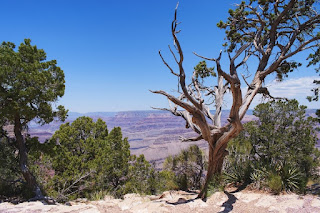 |
Grand Canyon scene with trees framing both sides by 398336 at
https://pixabay.com/photos/grand-canyon-landscape-nature-1893380/ |
This world history resource focuses on the Americas
from 40,000 B.C. to A.D. 700 and includes quiz questions
and answers and video links to related topics.
I utilized World History: Patterns of Interaction (Holt McDougal)
for our world history textbook.
It has multiple options for different learning styles
and covers a wide array of information.
This quiz accompanies Chapter 9: pages 232-259.
Directions for the quiz:
- Scroll down and click on the thumbnail to enlarge to full screen.
- Click on the graphic to advance to the next screen.
- Choose an answer for each question.
- Compare your answers with those provided.
If you are interested in a group and/or interactive version of this quiz,
log in to Kahoot! and search for Week 9 World History by Katrena.
Below are free videos to accompany chapter 9:
Thanks for visiting Student Survive to Thrive.
Find more of my articles via the site map, topics on the right,
or use my search bar.
Here are a few of my articles you may find helpful this week:
 |
| World History Week 9: The Americas 40,000 B.C. to A.D. 700 |
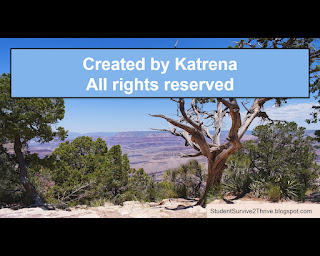 |
| Created by Katrena. All rights reserved. |
 |
| Thousands of years ago, a land bridge named ______ was thought to connect Asia and the Americas. Answer choices include: Pont d’Arc, Beringia, Fairy Bridge, Pravčická Braná |
 |
| The correct answer is Beringia. |
 |
| What is thought to have been the most important early crop in Mexico? Answer choices include: maize, squash, gourds, avocados |
 |
| The correct answer is maize. |
 |
| Floating gardens in Mexico only produced about ⅓ the harvests produced by landlocked gardens. Answer choices include: true, false |
 |
| The correct answer is false. |
 |
| The ____ civilization lived along Mexico’s Gulf Coast around 1200-400 B.C. & are considered Mesoamerica’s “mother culture.” Answer choices include: Aztec, Maya, Inca, Olmec |
 |
| The correct answer is Olmec. |
 |
| The Zapotec civilization built the first urban center in the Americas called ______. Answer choices include: St. Augustine, Aspero, Monte Albán, Flores |
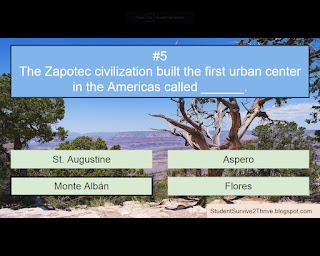 |
| The correct answer is Monte Albán. |
 |
| Many surviving Olmec carvings featured _______. Answer choices include: ferrets, mammoths, tortoises, jaguars |
 |
| The correct answer is jaguars. |
 |
| In South America, the earliest Chavin archaelogical remnants have been found in the Andes Mountains in what is now ____. Answer choices include: Peru, Brazil, Panama, Bolivia |
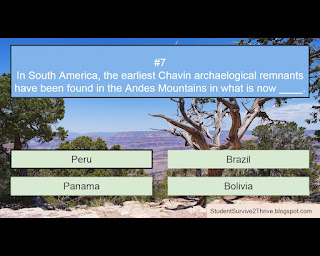 |
| The correct answer is Peru. |
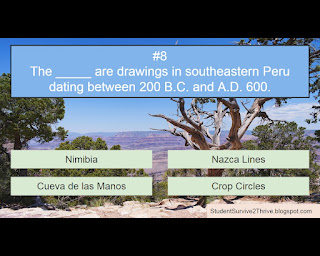 |
| The _____ are drawings in southeastern Peru dating between 200 B.C. and A.D. 600. Answer choices include: Nimibia, Nazca Lines, Cueva de las Manos, Crop Circles |
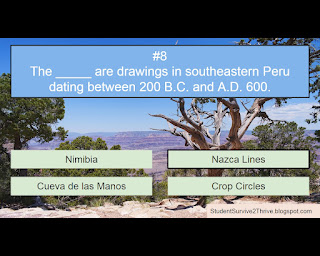 |
| The correct answer is Nazca Lines. |
 |
| The ____ of the Moche civilization depict(s) art scenes from everyday life. Answer choices include: weapons, cookware, trees, pottery |
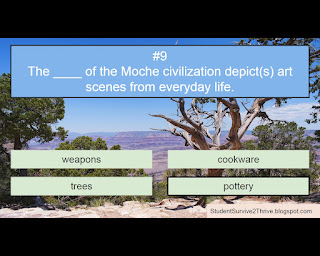 |
| The correct answer is pottery. |
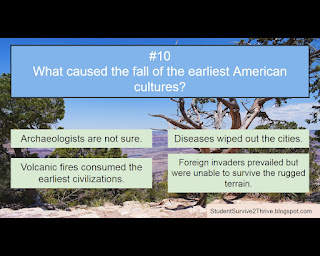 |
| What caused the fall of the earliest American cultures? Answer choices include: Archaeologists are not sure. Diseases wiped out the cities. Volcanic fires consumed the earliest civilizations. Foreign invaders prevailed but were unable to survive the rugged terrain. |
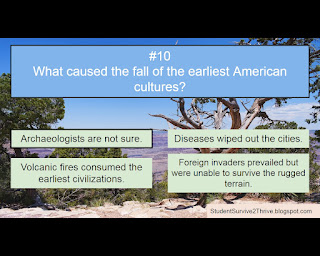 |
| The correct answer is: Archaeologists are not sure. |
 |
| Find more resources at StudentSurvive2Thrive.blogspot.com |
























No comments:
Post a Comment
Thanks for reading my article and sending your comment! Please note that I do not place links to other web sites on this blog.
Note: Only a member of this blog may post a comment.